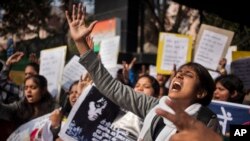Despite a ban put in place by India on a controversial BBC documentary on the infamous 2012 gang rape in New Delhi, the film has been viewed online by tens of thousands in the country.
The documentary has triggered frenzied debate on women’s issues and free speech.
Aditi Sengupta of New Delhi initially agreed with critics of BBC’s documentary “India’s Daughter” who slammed it for giving a platform to one of the rapists convicted in the brutal gang rape of a 23-year-old physiotherapy student, who later died of her injuries, two years ago.
Sengupta, 35, might never have watched the film, but her curiosity was piqued by the ban imposed by the government and the impassioned debates that followed. After viewing it online, she said has changed her mind.
“Shocked as I am for the mindset that it portrays, I think the documentary should be released, not just for the rapist, but for other people. More than the rapist, I was taken aback by the views of the lawyers,” she said.
Blamed victim
Mukesh Singh -- one of the six men involved in the gang rape -- has said the victim had only herself to blame for being out at night and that the savage beating that led to her death would not have happened if she had submitted rather than resisted the rapists.
Two defense lawyers for the four convicts in the gang rape case echoed similar sentiments.
One of them, A.K. Singh, said he would think nothing of burning his unmarried daughter or sister if they behaved improperly. Another said there was no place for women in Indian society.
The government said it banned the film in the interest of justice and public order, saying the documentary could create fear and tension. It said the heinous incident should not have been exploited for commercial purpose; a charge the filmmaker has denied.
But in the Internet era, the ban has been futile.
Although YouTube took down the link to the film, and government regulators have scrambled to remove links, videos with new titles have cropped up and links are being freely shared.
Like Sengupta, tens of thousands have watched it online.
Patriarchal attitudes
Viewers have barraged social media with their responses, many of them angry women decrying patriarchal attitudes in society.
And while initial attention focused on comments made by the rapist, which were used to promote the documentary, popular outrage has now turned on the two defense lawyers.
Women activists and sociologists point out that while the rapist is a criminal who comes from a poor background, the lawyers are from an educated strata.
Sociologist Dipankar Gupta in New Delhi said their comments demonstrated how brutal and boorish they were.
“That was absolutely obnoxious, it was frightening to hear it. In fact, I think if this film is seen by a large audience, many of them might recognize the demons inside them and might be able to exorcise those demons when they see how those two people spoke. … Even the rapists parents did not come out defending rape the way these two lawyers did,” Gupta said.
The outcry has prompted the Bar Council of India to issue notices to the two lawyers asking them to explain why disciplinary action should not be taken against them.
The massive street protests India witnessed in the weeks after the gang rape had prompted many initiatives to address the issue of patriarchal mindsets.
After watching the film, Krishna Mazumdar, general secretary of the National Federation of Indian Women, said much more needed to be done. She said out that too often, public figures have echoed similar sentiments -- that girls are more to blame for rape than boys.
“If enough was being done, then we would not have these so-called educated people like the lawyers saying these kind of things. It just goes to show that our education, our socializing, there is something terribly wrong. Obviously enough is not being done to fight these values that seem to be so much a part of our society,” Mazumdar said.
Cultural attitudes
Some women activists have supported the ban, saying the film reveals nothing new about Indian cultural attitudes and the mindset it exposes. Lawyers said a convict on death row whose appeal is pending in the Supreme Court should not have been given a chance to speak on a public platform.
But many have slammed the government for blocking the documentary, saying it amounts to muzzling free speech.
Bhavana Gupta, 32, who works in New Delhi, said debate and discussion should be encouraged, not stopped.
“I think the government is trying to really control the kind of information that is going out, that way this movie has really added fuel to that debate,” Gupta said.
The Editors Guild of India has asked the government to revoke the ban, calling it wholly unwarranted. It said the film was positive and powerful touching on the freedom, dignity and safety of women.
N. Bhaskara Rao of the Center of Media Studies in New Delhi said bans are often counterproductive.
“In a free, democratic, vocal society, banning anything adds more ferocity, more people want to see it. That’s why banning is no good, transparency is any time better,” Rao said.
Some outraged lawmakers have said the documentary was an attempt to malign India. But many said the ban is more likely to hurt the country's image as a vibrant, tolerant democracy.
Among them is the documentary’s director, Leslee Udwin, who said India has committed “international suicide” by banning the film.
Udwin said she was inspired to make the film by the protests after the 2012 gang rape and her purpose had been to show India as a country where one could actually see change beginning.








